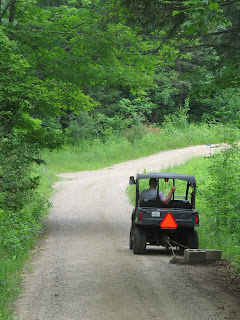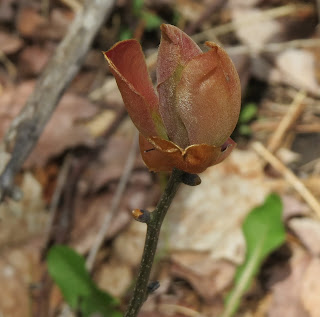You can't have lovely Monarch Butterflies without this plant, shown above. This is common Milkweed, Asclepias syriaca, the most widely distributed milkweed in our area. We call it a weed, but look at those flowers! Stunning! Monarch larvae (caterpillars) feed ONLY on milkweeds. Another milkweed found in our area is the Swamp Milkweed, which is even more colourful.
Above is another photo of Aralia racemosa, or Spikenard, an uncommon relative of Sarsapirilla, as detailed in a previous blog in this series. This is a splendid shrub-like (3-6 feet high and wide) flowering plant that would be a great addition to any backyard in our area. Look for it in a wildflower garden centre.
The Charlotte Lake cottage that we rented is on a very long private road which is maintained by local residents. We were fascinated by the simple and effective method for grading the road: an ATV dragging a metal grate weighed down by concrete blocks.
Above is Hairy Wood-mint, Blephilia hirsuta. Note long stalks of leaves differentiate it from Downy Wood Mint. Also, as "hirsuta" suggests, it is hairy along leaf stems. The Mint family is well represented in North America with many species which are widely distributed. You may recognize a close relative of this forest plant: Heal-all or Self-heal, Prunella vulgaris, which, if you are silly enough to maintain a lawn, you have probably pulled on numerous occasions. The name of the latter plant derives from its traditional application as a sore throat remedy. I prefer Ricola. This throat lozenge contains extracts from 11 herbs, including several common Mint family plants. Most cough drops contain menthol, which, as the name suggests, is an alcohol derivative of mint oil.
Above is a small flowering plant with round basal shiny leaves, and white flowers with protruding stamen: Round-leaved Pyrola, Pyrola rotundifolia.
The Pyrolaceae (Pyrola family), now considered a sub-family of the Heaths, is well represented on our forest floors. Some of my favourites are the Wintergreens...always a thrill to a young person to savour their first Wintergreen leaf...and the Pipsissewa. Don't try pronouncing the latter after 3 glasses of wine. The results might be, umm, unintentionally entertaining.
Tall Meadow Rue, Thalictrum polygamum, above, is a deep forest plant which is not often seen flowering. This was my lucky day.
Marsh Bedstraw, Galium palustre. Note this species lives in wet places, is weak stemmed (this one certainly is) has 6 leaves in whorls and WHITE flowers (Northern Bedstraw is more erect with white flowers, and has 4 leaves in whorls). Of course, the best way to identify a plant, or anything else in nature, is in the field. As you can see above and below, the field guide is with me, and the plant may be compared directly to the description, drawings, and photos. Bedstraw has tiny white 4-petaled flowers. The size compares to the weave of my lovely Levi Jeans (541's...more stretchy for an old waistline!)
Common Speedwell, Veronica officinalis is a species of flowering plant in the Plantain family Plantaginaceae. It is native to Europe and western Asia. It has been introduced to North America where it is widely naturalized.
Above is a buttercup. You already knew that! You used to hold one of the flowers under your chin to prove you liked butter. There are 7 species of Buttercups (Ranunculus spp.) in our region. Some of them are native, but the most common one (probably the above specimen included) is Tall Buttercup, Ranunculus acris, which is exotic, and invasive....but still delightful to us kids! If you want to know which species this is for certain, take a photo of the leaves! I didn't. Mea culpa.
As you will appreciate and recognize, this series of photos was taken to review some of the more widespread, common, and often exotic flowers we see in summer in open spaces, and along roadsides, fields and trails. The flowers above are not associated with most of the leaves, which appear to be nettles and grasses. The flowers are the exotic, and ubiquitous Chysanthemum leucanthemum (a rhyming mouthful), or Daisy.
Another common import from Europe is the Rough-fruited Cinquefoil, Potentilla recta. I love the notched petals of the subtly coloured flowers. French speakers will recognize the common name means "5 leaves". Ironically, this species usually has 7 leaflets on each leaf stock.
A great Yiddish word is "kvetch", which, roughly translated means "constantly complaining". I always think of that word when I see this plant: a non-native member of the Pea family called Cow Vetch, Viccia cracca. Like most of this family, the roots fix nitrogen, enriching soil. The flowers are rich in nectar, attracting bees and buterflies. As the name suggests, this is a sweet cattle favourite.
Of course, you also popped the above "fruits" of the ever-present Bladder Campion, Silene vulgaris, or, if you are in the USA, Maiden's Tears (awwwww). The fruit is actually the calyx, enclosing the green seed-bearing fruit. At this stage, if you pick the fruits, you can pop them against your hand. When they flower, the calyx is a lovely pink colour (and they are a member of the Pink family), and the petals are white. They are so lovely.
In their native Europe, these plants are treasured as a salad constituent, especially in the southern Mediterranean, where the young shoots and leaves are added to salad. Older leaves are boiled or fried, according ot Wikipedia. When I visit Spain in February, 2019, I will attempt to corroborate this.
Another treasured "weed" is the Common St. Johnswort, Hypericum perforatum. This native of Mediterranean Europe and North Africa (like the Bladder Campion), was introduced to North America by the invading European humanoid bipeds. They brought it with them because it has always been used in traditional medicine. It has been shown to have some anti-depressant qualities, though not sufficient to replace prescription medications. Enjoy its colour and leave it be!
St. Johnswort is also toxic to livestock, and is therefore unwelcome in pastures.
The name derives from traditional harvest on St. John's Day (June 24). The Latin name is derived from Greek (hyper=over and eikon=picture), since sprigs were hung over photos on St. John's Day to ward off evil. Hmm....I wonder if I could use it over a photo of Donald Trump? Which reminds me of my peridontist's joke, as he was pulling my tooth a few weeks ago: "Nickname for Donald Trump? The Manchurian Cantaloupe." An explanation is available for a small fee.
This is an introduction to a few native plants that have become more successful due to agriculture and development. Above is Staghorn Sumac, Rhus typhina. The staghorns turn their familiar reddish colour later in summer, when birds, pollinators and me all partake of their tangy flavour. They make an excellent herbal tea, the tanginess is due to Vitamin C. Beware though, some people may have allergies.
Staghorn Sumac is native to Eastern North America, and it is planted elsewhere. I have one in my garden. The downside of this great fast growing tall shrub is that it spreads through underground stems that have to be continually cut during spring and summer. I think the result is worth it.
Staghorn Sumac is one of many plants in the Anacardiaceae family, which includes poison ivy and poison sumac. The family includes other familiar fruit bearing edibles, like mangos and cashews.
Another familiar eastern native flower is the Black-eyed Susan, or Rudbeckia hirta. This colourful flower dominates my garden in late summer. With this plant's close cousins, the Coneflowers, Rudbeckia flowers are native to most everywhere on this continent.
Next year, get a few of these "weeds" in your garden. They are well adapted to our conditions in the Great Lakes Region, and therefore, require much less care than those unwanted exotics.
We will conclude our "Charlotte Lake" series next time, and include some post cottage August favourites.



































































